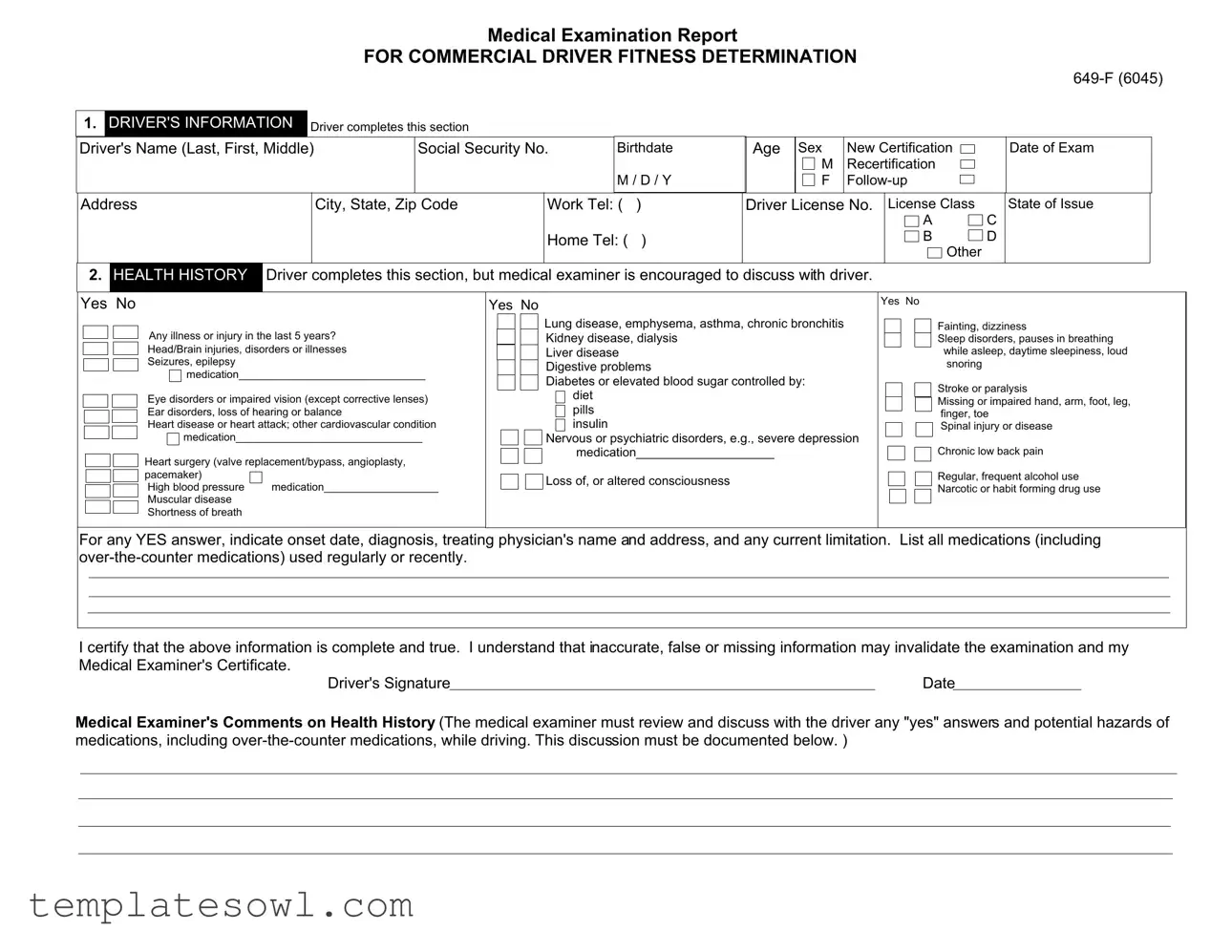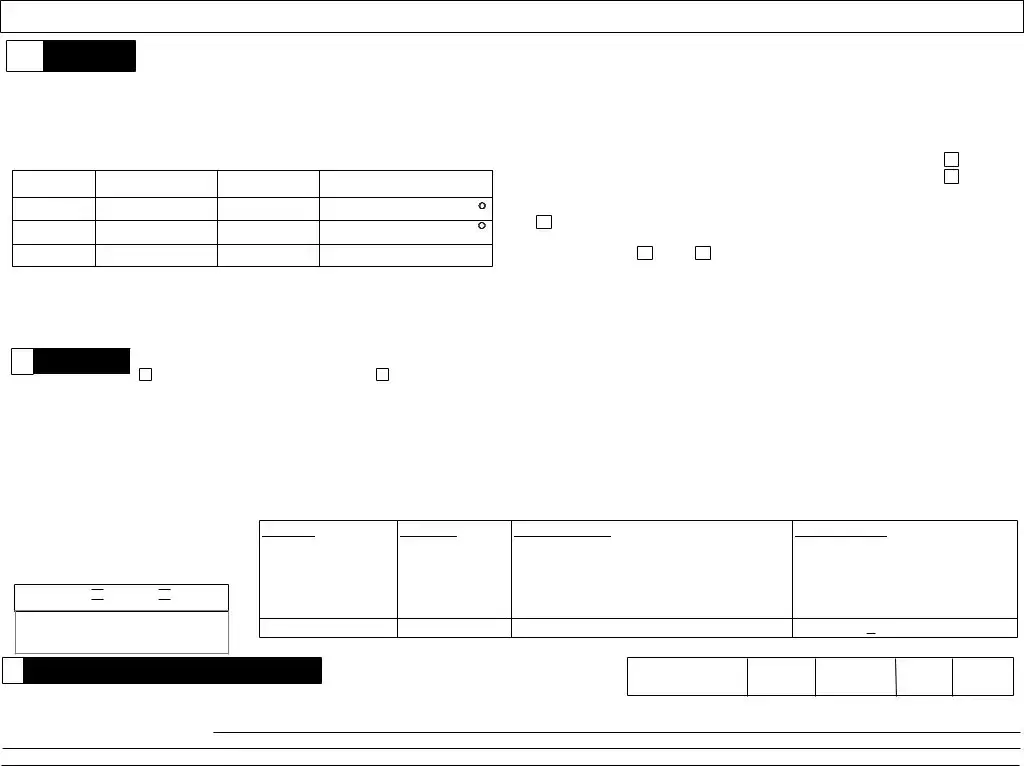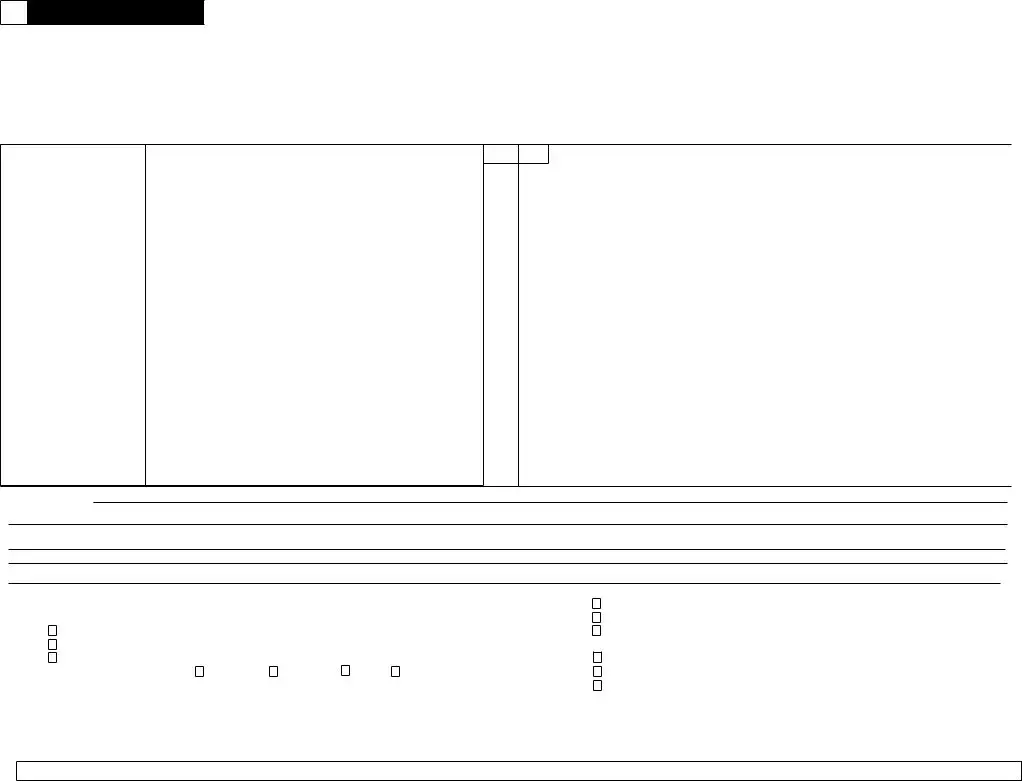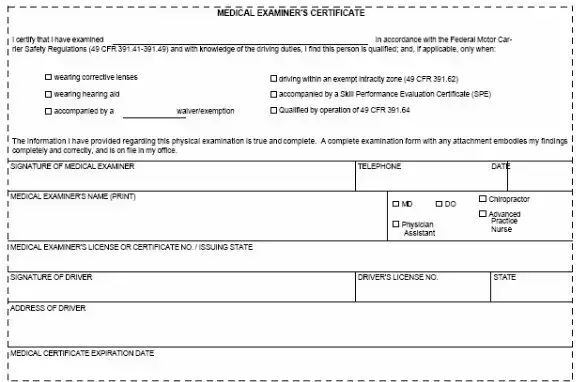Medical Examination Report
FOR COMMERCIAL DRIVER FITNESS DETERMINATION
1. |
DRIVER'S INFORMATION |
Driver completes this section |
|
Driver's Name (Last, First, Middle) |
Social Security No. |
Birthdate |
|
|
|
|
M / D / Y |
|
|
|
|
|
Sex |
New Certification |
M |
Recertification |
F |
Follow-up |
|
|
649-F (6045)
Date of Exam
Address |
City, State, Zip Code |
Work Tel: ( |
) |
|
|
Home Tel: ( |
) |
|
|
|
|
|
|
|
|
|
|
Driver License No. |
License Class |
|
State of Issue |
|
|
|
A |
C |
|
|
|
|
B |
D |
|
|
|
|
Other |
|
|
|
|
|
|
|
|
|
|
|
|
|
|
|
|
|
|
|
|
|
|
|
|
|
|
|
|
2. |
HEALTH HISTORY |
Driver completes this section, but medical examiner is encouraged to discuss with driver. |
|
|
|
|
|
|
|
|
|
|
|
|
|
|
|
|
|
|
|
|
|
|
|
|
Yes No |
|
Yes No |
Yes No |
|
|
|
|
|
|
|
|
|
Any illness or injury in the last 5 years? |
|
|
|
|
|
|
|
Lung disease, emphysema, asthma, chronic bronchitis |
|
|
|
|
Fainting, dizziness |
|
|
|
|
|
|
|
|
|
|
|
|
|
|
|
|
|
|
|
|
|
|
|
|
Kidney disease, dialysis |
|
|
|
|
Sleep disorders, pauses in breathing |
|
|
|
Head/Brain injuries, disorders or illnesses |
|
|
|
|
|
|
|
Liver disease |
|
|
|
|
while asleep, daytime sleepiness, loud |
|
|
|
|
|
|
Seizures, epilepsy |
|
|
|
|
|
|
|
|
Digestive problems |
|
|
|
|
snoring |
|
|
|
medication_______________________________ |
|
|
|
|
|
|
|
|
|
|
|
|
|
|
|
|
|
|
|
|
|
|
Diabetes or elevated blood sugar controlled by: |
|
|
|
|
Stroke or paralysis |
|
|
|
|
|
|
|
|
|
|
|
|
|
|
|
|
|
|
|
|
|
|
|
|
|
|
|
|
|
|
|
|
|
|
|
Eye disorders or impaired vision (except corrective lenses) |
|
|
|
|
|
|
|
diet |
|
|
|
|
|
|
|
|
|
|
|
|
|
|
pills |
|
|
|
|
Missing or impaired hand, arm, foot, leg, |
|
|
|
Ear disorders, loss of hearing or balance |
|
|
|
|
|
|
|
|
|
|
|
finger, toe |
|
|
|
|
|
|
|
|
|
|
|
|
|
|
|
|
|
Heart disease or heart attack; other cardiovascular condition |
|
|
|
|
|
|
|
insulin |
|
|
|
|
Spinal injury or disease |
|
|
|
|
|
|
medication_______________________________ |
|
|
|
|
|
|
|
Nervous or psychiatric disorders, e.g., severe depression |
|
|
|
|
Chronic low back pain |
|
|
|
|
|
|
|
|
|
|
Heart surgery (valve replacement/bypass, angioplasty, |
|
|
|
|
|
|
|
medication____________________ |
|
|
|
|
|
|
|
|
|
|
|
|
|
|
|
|
|
|
|
|
|
pacemaker) |
|
|
|
|
|
|
|
|
Loss of, or altered consciousness |
|
|
|
|
Regular, frequent alcohol use |
|
|
|
|
|
|
|
|
|
|
|
|
|
|
|
|
|
|
High blood pressure |
medication___________________ |
|
|
|
|
|
|
|
|
|
|
|
Narcotic or habit forming drug use |
|
|
|
|
|
|
|
|
|
|
|
|
|
|
|
|
|
|
|
Muscular disease |
|
|
|
|
|
|
|
|
|
|
|
|
|
|
|
|
|
|
|
|
|
|
|
|
|
|
|
|
|
|
|
|
|
|
|
|
Shortness of breath |
|
|
|
|
|
|
|
|
|
|
|
|
|
|
|
|
|
|
|
|
|
|
|
|
|
|
|
|
|
|
|
|
|
|
|
|
|
|
|
|
|
|
|
|
|
|
|
|
|
|
|
|
For any YES answer, indicate onset date, diagnosis, treating physician's name and address, and any current limitation. List all medications (including over-the-counter medications) used regularly or recently.
I certify that the above information is complete and true. I understand that inaccurate, false or missing information may invalidate the examination and my Medical Examiner's Certificate.
Medical Examiner's Comments on Health History (The medical examiner must review and discuss with the driver any "yes" answers and potential hazards of medications, including over-the-counter medications, while driving. This discussion must be documented below. )
TESTING (Medical Examiner completes Section 3 through 7) NAME: LAST, |
FIRST, |
MIDDLE, |
Standard: At least 20/40 acuity (Snellen) in each eye with or without correction. At least 70 degrees peripheral in horizontal meridian measured in each eye. The use of corrective lenses should be noted on the Medical Examiner's Certificate.
INSTRUCTIONS: When other than the Snellen chart is used, give test results in Snellen-comparable values. In recording distance vision, use 20 feet as normal. Report visual acuity as a ratio with 20 as numerator and the smallest type read at 20 feet as denominator. If the applicant wears corrective lenses, these should be worn while visual acuity is being tested. If the driver habitually wears contact lenses, or intends to do so while driving, sufficient evidence of good tolerance and adaptation to their use must be obvious. Monocular drivers are not qualified.
Numerical readings must be provided. |
|
Applicant can recognize and distinguish among traffic control |
ACUITY |
UNCORRECTED |
CORRECTED |
HORIZONTAL FIELD OF VISION |
signals and devices showing standard red, green, and amber colors ? |
|
|
|
Right Eye |
20/ |
20/ |
Right Eye |
Applicant meets visual acuity requirement only when wearing: |
Left Eye |
20/ |
20/ |
Left Eye |
Corrective Lenses |
|
|
|
|
Both Eyes |
20/ |
20/ |
|
Monocular Vision: |
Yes |
No |
|
|
|
|
Complete next line only if vision testing is done by an opthalmologist or optometrist
|
|
|
|
|
|
|
|
|
Date of Examination Name of Ophthalmologist or Optometrist (print) Tel. No. |
|
License No./ State of Issue |
Signature |
4.HEARING Standard: a) Must first perceive forced whispered voice > 5 ft., with or without hearing aid, or b) average hearing loss in better ear < 40 dB
Check if hearing aid used for tests.
Check if hearing aid required to meet standard.
INSTRUCTIONS: To convert audiometric test results from ISO to ANSI, -14 dB from ISO for 500Hz, -10dB for 1,000 Hz, -8.5 dB for 2000 Hz. To average, add the readings for 3 frequencies tested and divide by 3.
Numerical readings must be recorded.
a) Record distance from individual at which |
Right ear |
Left Ear |
forced whispered voice can first be heard. |
\ Feet |
\ Feet |
|
|
|
|
Right Ear |
|
|
Left Ear |
|
|
|
|
|
|
|
|
|
b) If audiometer is used, record hearing loss in |
500 Hz |
1000 Hz |
2000 Hz |
500 Hz |
1000 Hz |
2000 Hz |
|
|
|
|
|
|
decibels. (acc. to ANSI Z24.5-1951) |
|
|
|
|
|
|
|
Average: |
|
|
Average: |
|
|
|
|
|
|
|
|
|
5. |
BLOOD PRESSURE/ PULSE RATE |
Numerical readings must be recorded. Medical Examiner should take at least two readings to confirm BP. |
|
|
|
Blood |
Systolic |
Diastolic |
Pressure |
|
|
|
|
|
Driver qualified if <140/90.
Pulse Rate: 
 Regular
Regular 
 Irregular
Irregular
Reading |
Category |
Expiration Date |
Recertification |
|
|
|
|
140-159/90-99 |
Stage 1 |
1 year |
1 year if <140/90. |
|
|
|
One-time certificate for 3 months if |
|
|
|
141-159/91-99. |
160-179/100-109 |
Stage 2 |
One-time certificate for 3 months. |
1 year from date of exam if <140/90 |
6 months from date of exam if <140/90
6.LABORATORY AND OTHER TEST FINDINGS
Numerical readings must be recorded. |
SP. GR. PROTEIN BLOOD SUGAR |
|
URINE SPECIMEN |
Urinalysis is required. Protein, blood or sugar in the urine may be an indication for further testing to rule out any underlying medical problem.
Other Testing (Describe and record)
PHYSICAL EXAMINATION |
|
Height: |
(in.) Weight: |
(lbs.) |
NAME: LAST, |
FIRST, |
MIDDLE, |
|
|
|
|
|
|
|
|
|
|
|
|
|
|
|
|
|
|
|
|
|
The presence of a certain condition may not necessarily disqualify a driver, particularly if the condition is controlled adequately, is not likely to worsen or is readily amenable to treatment. Even if a condition does not disqualify a driver, the medical examiner may consider deferring the driver temporarily. Also, the driver should be advised to take the necessary steps to correct the condition as soon as possible particularly if the condition, if neglected, could result in more serious illness that might affect driving.
Check YES if there are any abnormalities. Check NO if the body system is normal. Discuss any YES answers in detail in the space below, and indicate whether it would affect the driver's ability to operate a commercial motor vehicle safely. Enter applicable item number before each comment. If organic disease is present, note that it has been compensated for.
See Instructions to the Medical Examiner for guidance.
BODY SYSTEM
1.General Appearance
2.Eyes
3.Ears
4.Mouth and Throat
5.Heart
6.Lungs and chest, not including breast examination
CHECK FOR:
Marked overweight, tremor, signs of alcoholism, problem drinking, or drug abuse.
Pupillary equality, reaction to light, accommodation, ocular motility, ocular muscle imbalance, extraocular movement, nystagmus, exophthalmos. Ask about retinopathy, cataracts, aphakia, glaucoma, macular degeneration and refer to a specialist if appropriate.
Scarring of tympanic membrane, occlusion of external canal, perforated eardrums.
Irremediable deformities likely to interfere with breathing or swallowing.
Murmurs, extra sounds, enlarged heart, pacemaker, implantable defibrillator.
Abnormal chest wall expansion, abnormal respiratory rate, abnormal breath sounds including wheezes or alveolar rales, impaired respiratory function, cyanosis. Abnormal findings on physical exam may require further testing such as pulmonary tests and/ or xray of chest.
|
BODY SYSTEM |
CHECK FOR: |
YES* |
NO |
|
7. Abdomen and Viscera |
Enlarged liver, enlarged spleen, masses, bruits, |
|
|
|
|
hernia, significant abdominal wall muscle |
|
|
|
|
weakness. |
|
|
|
8. Vascular System |
Abnormal pulse and amplitude, cartoid or |
|
|
|
|
|
|
|
|
arterial bruits, varicose veins. |
|
|
|
9. Genito-urinary System |
Hernias. |
|
|
|
10. Extremities- Limb |
Loss or impairment of leg, foot, toe, arm, hand, |
|
|
|
impaired. Driver may |
finger, Perceptible limp, deformities, atrophy, |
|
|
|
be subject to SPE |
weakness, paralysis, clubbing, edema, |
|
|
|
hypotonia. Insufficicent grasp and prehension |
|
|
|
certificate if otherwise |
|
|
|
in upper limb to maintain steering wheel grip. |
|
|
|
qualified. |
|
|
|
Insufficient mobility and strength in lower limb |
|
|
|
|
|
|
|
|
to operate pedals properly. |
|
|
|
11. Spine, other |
Previous surgery, deformities, limitation of |
|
|
|
musculoskeletal |
motion, tenderness. |
|
|
|
12. Neurological |
Impaired equilibrium, coordination or speech |
|
|
|
pattern; asymmetric deep tendon reflexes, |
|
|
|
|
|
|
|
|
sensory or positional abnormalities, abnormal |
|
|
|
|
patellar and Babinki's reflexes, ataxia. |
|
|
|
|
|
|
|
*COMMENTS:
Note certification status here. See Instructions to the Medical Examiner for guidance. |
|
|
Wearing corrective lense |
|
|
|
|
|
|
|
|
|
|
|
|
Wearing hearing aid |
|
|
|
|
Meets standards in 49 CFR 391.41; qualifies for 2 year certificate |
|
|
Accompanied by a |
|
|
waiver/ exemption. Driver must present |
|
|
|
|
Does not meet standards |
|
|
|
|
|
|
|
exemption at time of certification. |
|
|
|
|
Meets standards, but periodic monitoring required due to |
|
. |
|
|
Skill Performance Evaluation (SPE) Certificate |
|
|
|
|
Driver qualified only for: 3 months |
6 months |
1 year |
Other |
|
|
Driving within an exempt intracity zone (See 49 CFR 391.62) |
|
|
|
|
|
|
|
|
Qualified by operation of 49 CFR 391.64 |
|
|
|
|
|
|
|
Medical Examiner's signature |
|
|
|
|
|
Temporarily disqualified due to (condition or medication): |
|
|
Medical Examiner's name |
|
|
|
|
|
|
|
|
|
|
|
Address |
|
|
|
|
|
|
|
|
|
|
|
|
|
|
|
|
|
|
|
|
|
|
|
|
|
Return to medical examiner's office for follow up on |
|
|
|
|
|
Telephone Number |
|
|
|
|
|
|
|
|
|
|
|
|
|
|
If meets standards, complete a Medical Examiner's Certificate as stated in 49 CFR 391.43(h). (Driver must carry certificate when operating a commercial vehicle.)

49 CFR 391.41 Physical Qualifications for Drivers
THE DRIVER'S ROLE
Responsibilities, work schedules, physical and emotional demands, and lifestyles among commercial drivers vary by the type of driving that they do. Some of the main types of drivers include the following: turn around or short relay (drivers return to their home base each evening); long relay (drivers drive 9-11 hours and then have at least a 10-hour off-duty period), straight through haul (cross country drivers); and team drivers (drivers share the driving by alternating their 5-hour driving periods and 5-hour rest periods.)
The following factors may be involved in a driver's performance of duties: abrupt schedule changes and rotating work schedules, which may result in irregular sleep patterns and a driver beginning a trip in a fatigued condition; long hours; extended time away from family and friends, which may result in lack of social support; tight pickup and delivery schedules, with irregularity in work, rest, and eating patterns, adverse road, weather and traffic conditions, which may cause delays and lead to hurriedly loading or unloading cargo in order to compensate for the lost time; and environmental conditions such as excessive vibration, noise, and extremes in temperature. Transporting passengers or hazardous materials may add to the demands on the commercial driver.
There may be duties in addition to the driving task for which a driver is responsible and needs to be fit. Some of these responsibilities are: coupling and uncoupling trailer(s) from the tractor, loading and unloading trailer(s) (sometimes a driver may lift a heavy load or unload as much as 50,000 lbs. of freight after sitting for a long period of time without any stretching period); inspecting the operating condition of tractor and/or trailer(s) before, during and after delivery of cargo; lifting, installing, and removing heavy tire chains; and, lifting heavy tarpaulins to cover open top trailers. The above tasks demand agility, the ability to bend and stoop, the ability to maintain a crouching position to inspect the underside of the vehicle, frequent entering and exiting of the cab, and the ability to climb ladders on the tractor and/or trailer(s).
In addition, a driver must have the perceptual skills to monitor a sometimes complex driving situation, the judgment skills to make quick decisions, when necessary, and the manipulative skills to control an oversize steering wheel, shift gears using a manual transmission, and maneuver a vehicle in crowded areas.
§391.45 PHYSICAL QUALIFICATIONS FOR DRIVERS
(a)A person shall not drive a commercial motor vehicle unless he is physically qualified to do so and, except as provided in §391.67, has on his person the original, or a photographic copy, of a medical examiner's certificate that he is physically qualified to drive a commercial motor vehicle.
(b)A person is physically qualified to drive a motor vehicle if that person:
(1)Has no loss of a foot, a leg, a hand, or an arm, or has been granted a Skill Performance Evaluation (SPE) Certificate (formerly Limb Waiver Program) pursuant to §391.49.
(2)Has no impairment of: (i) A hand or finger which interferes with prehension or power grasping; or (ii) An arm, foot, or leg which interferes with the ability to perform normal tasks associated with operating a commercial motor vehicle; or any other significant limb defect or limitation which interferes with the ability to perform normal tasks associated with operating a commercial motor vehicle; or has been granted a SPE Certificate pursuant to §391.49.
(3)Has no established medical history or clinical diagnosis of diabetes mellitus currently requiring insulin for control;
(4)Has no current clinical diagnosis of myocardial infarction, angina pectoris, coronary insufficiency, thrombosis, or any other cardiovascular disease of a variety known to be accompanied by syncope, dyspnea, collapse, or congestive cardiac failure.
(5)Has no established medical history or clinical diagnosis of a respiratory dysfunction likely to interfere with his ability to control and drive a commercial motor vehicle safely.
(6)Has no current clinical diagnosis of high blood pressure likely to interfere with his ability to operate a commercial motor vehicle safely.
(7)Has no established medical history or clinical diagnosis of rheumatic, arthritic, orthopedic, muscular, neuromuscular, or vascular disease which interferes with his ability to control and operate a commercial motor vehicle safely.
(8)Has no established medical history or clinical diagnosis of epilepsy or any other condition which is likely to cause loss of consciousness or any loss of ability to control a commercial motor vehicle;
(9)Has no mental, nervous, organic, or functional disease or psychiatric disorder likely to interfere with his ability to drive a commercial motor vehicle safely;
(10)Has distant visual acuity of at least 20/40 (Snellen) in each eye without corrective lenses or visual acuity separately corrected to 20/40 (Snellen) or better with corrective lenses, distant binocular acuity of at least 20/40 (Snellen) in both eyes with or without corrective lenses, field of vision of at least 70 degrees in the horizontal meridian in each eye, and the ability to recognize the colors of traffic signals and devices showing standard red, green and amber;
(11)First perceives a forced whispered voice in the better ear not less than 5 feet with or without the use of a hearing aid, or, if tested by use of an audiometric device, does not have an average hearing loss in the better ear greater than 40 decibels at 500 Hz, 1,000 Hz and 2,000 Hz with or without a hearing device when the audiometric device is calibrated to the American National Standard (formerly ASA Standard)
Z24.5-1951;
(12)(i) Does not use a controlled substance identified in 21 CFR 1308.11 Schedule I, an amphetamine, a narcotic, or any other habit-forming drug. (ii) Exception: A driver may use such a substance or drug, if the substance or drug is prescribed by a licensed medical practitioner who: (A) Is familiar with the driver's medical history and assigned duties; and (B) Has advised the driver that the prescribed substance or drug will not adversely affect the driver's ability to safely operate a commercial motor vehicle; and
(13)Has no current clinical diagnosis of
alcoholism.
INSTRUCTIONS TO THE MEDICAL EXAMINER
General Information
The purpose of this examination is to determine a driver's physical qualification to operate a commercial motor vehicle (CMV) in interstate
Federal Motor Carrier Safety Regulations
-Advisory Criteria-
commerce according to the requirements in 49 CFR 391.41-49. Therefore, the medical examiner must be knowledgeable of these requirements and guidelines developed by the FMCSA to assist the medical examiner in making the qualification determination. The medical examiner should be familiar with the driver's responsibilities and work environment and is referred to the section on the form, The Driver's Role.
In addition to reviewing the Health History section with the driver and conducting the physical examination, the medical examiner should discuss common prescriptions and over-the-counter medications relative to the side effects and hazards of these medications while driving. Educate the driver to read warning labels on all medications. History of certain conditions may be cause for rejection, particularly if required by regulation, or may indicate the need for additional laboratory tests or more stringent examination perhaps by a medical specialist. These decisions are usually made by the medical examiner in light of the driver's job responsibilities, work schedule and potential for the conditions to render the driver unsafe.
Medical conditions should be recorded even if they are not cause for denial, and they should be discussed with the driver to encourage appropriate remedial care. This advice is especially needed when a condition, if neglected, could develop into a serious illness that could affect driving.
If the medical examiner determines that the driver is fit to drive and is also able to perform non-driving responsibilities as may be required, the medical examiner signs the medical certificate which the driver must carry with his/her license. The certificate must be dated. Under current regulations, the certificate is valid for two years, unless the driver has a medical condition that does not prohibit driving but does require more frequent monitoring. In such situations, the medical certificate should be issued for a shorter length of time. The physical examination should be done carefully and at least as complete as is indicated by the attached form. Contact the FMCSA at (202) 366-1790 for further information (a vision exemption, qualifying drivers under 49 CFR 391.64, etc.).
Interpretation of Medical Standards
Since the issuance of the regulations for physical qualifications of commercial drivers, the Federal Motor Carrier Safety Administration (FMCSA) has published recommendations called Advisory Criteria to help medical examiners in determining whether a driver meets the physical qualifications for commercial driving. These recommendations have been condensed to provide information to medical examiners that (1) is directly relevant to the physical examination and (2) is not already included in the medical examination form. The specific regulation is printed in italics and it's reference by section is highlighted.
Loss of Limb: §391.41(b)(1)
A person is physically qualified to drive a commercial motor vehicle if that person:
Has no loss of a foot, leg, hand or an arm, or has been granted a Skill Performance Evaluation (SPE) Certificate pursuant to Section 391.49.
Limb Impairment: §391.41(b)(2)
A person is physically qualified to drive a commercial motor vehicle if that person:
Has no impairment of: (i) A hand or finger which interferes with prehension or power grasping; or (ii) An arm, foot, or leg which interferes with the ability to perform normal tasks associated with operating a commercial motor vehicle; or (iii) Any other significant limb defect or limitation which interferes with the ability to perform normal tasks associated with operating a commercial motor vehicle; or (iv) Has been granted a Skill Performance Evaluation (SPE) Certificate pursuant to Section 391.49.
A person who suffers loss of a foot, leg, hand or arm or whose limb impairment in any way interferes with the safe performance of normal tasks associated with operating a commercial motor vehicle is subject to the Skill Performance Evaluation Certification Program pursuant to section 391.49, assuming the person is otherwise qualified.
With the advancement of technology, medical aids and equipment modifications have been developed to compensate for certain disabilities. The SPE Certification Program (formerly the Limb Waiver Program) was designed to allow persons with the loss of a foot or limb or with functional impairment to qualify under the Federal Motor Carrier Safety Regulations (FMCSRs) by use of prosthetic devices or equipment modifications which enable them to safely
operate a commercial motor vehicle. Since there are no medical aids equivalent to the original body or limb, certain risks are still present, and thus restrictions may be included on individual SPE certificates when a State Director for the FMCSA determines they are necessary to be consistent with safety and public interest.
If the driver is found otherwise medically qualified (391.41(b)(3) through (13)), the medical examiner must check on the medical certificate that the driver is qualified only if accompanied by a SPE certificate. The driver and the employing motor carrier are subject to appropriate penalty if the driver operates a motor vehicle in interstate or foreign commerce without a curent SPE certificate for his/her physical disability.
Diabetes §391.41(b)(3)
A person is physically qualified to drive a commercial motor vehicle if that person:
Has no established medical history or clinical diagnosis of diabetes mellitus currently requiring insulin for control.
Diabetes mellitus is a disease which, on occasion, can result in a loss of consciousness or disorientation in time and space. Individuals who require insulin for control have conditions which can get out of control by the use of too much or too little insulin, or food intake not consistent with the insulin dosage. Incapacitation may occur from symptoms of hyperglycemic or hypoglycemic reactions (drowsiness, semiconsciousness, diabetic coma or insulin shock).
The administration of insulin is, within itself, a complicated process requiring insulin, syringe, needle, alcohol sponge and a sterile technique. Factors related to long-haul commercial motor vehicle operations, such as fatigue, lack of sleep, poor diet, emotional conditions, stress, and concomitant illness, compound the dangers, the FMCSA has consistently held that a diabetic who uses insulin for control does not meet the minimum physical requirements of the FMCSRs.
Hypoglycemic drugs, taken orally, are sometimes prescribed for diabetic individuals to help stimulate natural body production of insulin. If the condition can be controlled by the use of oral medication and diet, then an individual may be qualified under the present rule. CMV drivers who do not meet the Federal diabetes standard may call (202) 366-1790 for an application for a diabetes exemption.
(See Conference Report on Diabetic Disorders and Commercial Drivers and Insulin-Using Commercial Motor Vehicle Drivers at: http://www.fmcsa.dot.gov/rulesregs/medreports.htm)
Cardiovascular Condition §391.41(b)(4)
A person is physically qualified to drive a commercial motor vehicle if that person:
Has no current clinical diagnosis of myocardial infarction, angina pectoris, coronary insufficiency, thrombosis or any other cardiovascular disease of a variety known to be accompanied by syncope, dyspnea, collapse or congestive cardiac failure.
The term "has no current clinical diagnosis of" is specifically designed to encompass: "a clinical diagnosis of" (1) a current cardiovascular condition, or (2) a cardiovascular condition which has not fully stabilized regardless of the time limit The term "known to BE
23, etc. The examiner should not use only sibilants (s sounding materials). The opposite ear should be tested in the same manner. If the individual fails the whispered voice test, the audiometric test should be administered.
If an individual meets the criteria by the use of a hearing aid, the following statement must appear on the Medical Examiner's Certificate "Qualified only when wearing a hearing aid."
(See Hearing Disorders and Commercial Motor Vehicle Drivers at: http://www/fmcsa.dot.gov/rulesregs/medrports.htm)
Drug Use §391.41(b)(12)
A person is physically qualified to drive a commercial motor vehicle if that person:
Does not use a controlled substance identified in 21 CFR 1308.II. Schedule I, an amphetamine, a narcotic, or any other habit-forming drug. Exception: A driver may use such a substance or drug, if the substance or drug is prescribed by a licensed medical practitioner who is familiar with the driver's medical history and assigned duties; and has advised the driver that the prescribed substance or drug will not adversely affect the driver's ability to safely operate a commercial motor vehicle.
This exception does not apply to methadone. The intent of the medical certification process is to medically evaluate a driver to ensure that the driver has no medical condition which interferes with the safe performance of driving tasks on a public road. If a driver uses a Schedule I drug or other substance, an amphetamine, a narcotic, or any other habit-forming drug, it may be cause for the driver to be found medically unqualified. Motor carriers are encouraged to obtain a practitioner's written statement about the effects on transportation safety of the use of a particular drug.
A test for controlled substances is not required as part of this biennial certification process. The FMCSA or the driver's employer should be contacted directly for information on controlled substances and alcohol testing under Part 382 of the FMCSRs.
The term "uses" is designed to encompass instances of prohibited drug use determined by a physician through established medical means. This may or may not involve body fluid testing. If body fluid testing takes place, positive test results should be confirmed by a second test of greater specificity. The term "habit-forming" is intended to include any drug or medication generally recognized as capable of becoming habitual, and which may impair the user's ability to operate a commercial motor vehicle safely.
The driver is medically unqualified for the duration of the prohibited drug(s) use and until a second examination shows the driver is free from the prohibited drug(s) use. Recertification may involve a substance abuse evaluation, the successful completion of a drug rehabilitation program, and a negative drug test result. Additionally, given that the certification period is normally two years, the examiner has the option to certify for a period of less than 2 years if this examiner determines more frequent monitoring is required.
(See Conference on Neurological Disorders and Commercial Drivers and Conference on Psychiatric Disorders and Commercial Drivers at: http://www.fmcsa.dot.gov/rulesregs/medreports.htm)
Alcoholism §391.41(b)(13)
A person is physically qualified to drive a commercial motor vehicle if that person:
Has no current clinical diagnosis of alcoholism.
The term "current clinical diagnosis of" is specifically designed to encompass a current alcoholic illness or those instances where the individual's physical condition has not fully stabilized, regardless of the time element. If an individual shows signs of having an alcohol-use problem, he or she should be referred to a specialist. After counseling




 Regular
Regular 
 Irregular
Irregular


